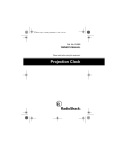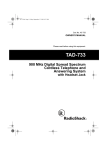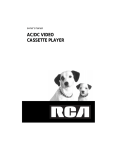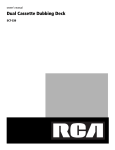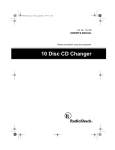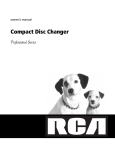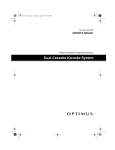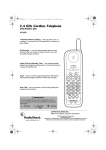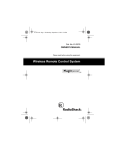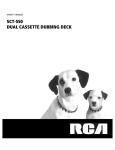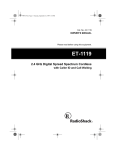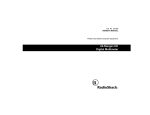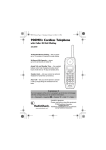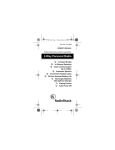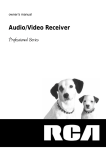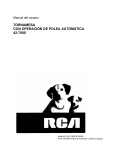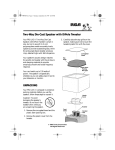Download RCA SCT-530 Cassette Player User Manual
Transcript
owner’s manual SCT-530 HIGH-SPEED DUBBING STEREO CASSETTE DECK PRB1199A.En.01.09.DOC 1 9/2/99, 9:22 PM FEATURES Your RCA SCT-530 High-Speed Dubbing Stereo Cassette Deck combines two cassette decks for professional-quality dubbing and the convenience of extended play. Its special features include: Dolby B Noise Reduction System — reduces tape hiss and background noise for the best possible audio recording. Auto Tape Selector — automatically adjusts equalization and bias to match the type of tape you play. Continuous Play — lets you set the deck to automatically play two tapes in sequence. High-Speed Dubbing — lets you copy tapes at twice the normal speed. Auto-Stop — protects the tape and the playback/record mechanisms by stopping playback or recording at the end of the tape. For your permanent records, we urge you to record your cassette deck’s serial number in the space below. You can find the serial number on the label on the back panel of the cassette deck. Serial Number: _____________________________________________ Warning: Most prerecorded tapes contain copyrighted material.Copying or dubbing of such material is a violation of copyright laws. 2 DOLBY B NR Dolby and the double-D symbol 2 are trademarks of Dolby Laboratories Licensing Corporation. Dolby Noise Reduction manufactured under license from Dolby Laboratories Licensing Corporation. ©1999 Tandy Corporation. All Rights Reserved. 2 PRB1199A.En.01.09.DOC 2 9/2/99, 9:22 PM IMPORTANT SAFETY INSTRUCTIONS This cassette deck is made and tested to meet exacting safety standards. It meets both UL and FCC requirements. Careful attention is devoted to quality standards in the manufacture of your cassette deck, and safety is a major factor in its design. However, safety is also your responsibility. This section lists important information that will help you properly use and enjoy your cassette deck and accessories. Read all the included safety and operating instructions before using your cassette deck, follow them closely, and retain them for future reference. Heed Warnings — Follow all warnings on the product and in the operating instructions. CAUTION RISK OF ELECTRIC SHOCK. DO NOT OPEN. CAUTION: TO REDUCE THE RISK OF ELECTRIC SHOCK, DO NOT REMOVE THE COVER. NO USER-SERVICEABLE PARTS INSIDE. REFER SERVICING TO QUALIFIED SERVICE PERSONNEL. This symbol is intended to alert you to the presence of dangerous voltage inside the product that can cause shock. Do not open the product’s case. This symbol is intended to alert you to important operating and maintenance instructions in this owner’s manual. WARNING: TO REDUCE THE RISK OF FIRE OR ELECTRIC SHOCK, DO NOT EXPOSE THIS APPLIANCE TO RAIN OR MOISTURE. Cleaning — Unplug this product from the wall outlet before cleaning. Use only a damp cloth for cleaning. Do not use liquid or aerosol cleaners. Attachments — Do not use attachments/accessories not recommended by the product manufacturer, as they might create a hazard. Water and Moisture — Do not use this product near water (for example, near a bathtub, washbowl, kitchen sink, or laundry tub; in a wet basement; or near a swimming pool). Accessories — Do not place this product on an unstable cart, stand, tripod, bracket, or table. The product may fall, causing serious injury to a child or adult, and serious damage to the product. Use only with a cart, stand, tripod, bracket, or table recommended by the manufacturer or sold with the product. Follow the manufacturer’s instructions for mounting, and use a recommended mounting accessory. Carts — Move the product on a cart carefully. Quick stops, excessive force, and uneven surfaces may cause the product/cart to overturn. Ventilation — Slots and openings in the cabinet provide ventilation, ensure reliable operation, and protect from overheating. Do not block or cover these openings, and do not place the product on a bed, sofa, rug, or other similar surface. Do not place the product in a built-in bookcase or rack unless it provides proper ventilation as specified by the manufacturer. Power Sources — Operate this product using only the power source indicated on its marking label. If you are not sure of your home’s power type, consult your product dealer or local power company. Polarization — This product is equipped with a polarized AC line plug (a plug having one blade wider than the other). This plug will fit in the power outlet only one way. This is a safety feature. If you cannot insert the plug fully into the outlet, try reversing the plug. If the plug still doesn’t fit, contact your electrician to replace your obsolete outlet. Do not defeat the safety purpose of the polarized plug. If you need an extension, use a polarized cord. Power-Cord Protection — Route power-supply cords so they are not likely to be walked on or pinched by items placed on or against them, paying particular attention to cords at plugs, convenience receptacles, and the point where they exit from the product. Lightning — For added protection for this product during a lightning storm, or when it is left unattended and unused for long periods of time, unplug it from the wall outlet and disconnect the antenna or cable system. This will prevent damage to the product due to lightning and power-line surges. Overloading — Do not overload wall outlets, extension cords, or integral convenience receptacles, as this can result in a risk of fire or electric shock. Objects and Liquids — Never push objects of any kind into this product through openings, as they may touch dangerous voltage points or short out parts that could result in a fire or electric shock. Never spill liquid of any kind on the product. This cassette deck complies with the limits for a Class B digital device as specified in Part 15 of FCC Rules. These limits provide reasonable protection against radio and TV interference in a residential area. However, your equipment might cause radio or TV interference even when it is operating properly. To eliminate interference, you can try one or more of the following corrective measures: Servicing — Do not attempt to service this product yourself, as opening or removing covers may expose you to dangerous voltage or other hazards. Refer all servicing to qualified service personnel. • Damage Requiring Service — Unplug this product from the wall outlet and refer servicing to qualified service personnel under the following conditions: • When the power-supply cord or plug is damaged. • If liquid has been spilled or objects have fallen into the product. Reorient or relocate the receiving antenna. • If the product has been exposed to rain or water. • Increase the distance between the cassette deck and the radio or TV • • Use outlets on different electrical circuits for the cassette deck and the radio or TV If the product does not operate normally by following the operating instructions. Adjust only those controls that are covered by the operating instructions, as an improper adjustment of other controls may result in damage and will often require extensive work by a qualified technician to restore the product to normal operation. • If the product has been dropped or damaged in any way. • When the product exhibits a distinct change in performance. Consult your local Radio Shack store or an experienced radio/TV technician if the problem still exists. Replacement Parts — When replacement parts are required, be sure the service technician uses replacement parts specified by the manufacturer or having the same characteristics as the original part. Unauthorized substitutions may result in fire, electric shock, or other hazards. Safety Check — Upon completion of service or repairs to this product, ask the service technician to perform safety checks to determine that the product is in proper operating condition. Wall or Ceiling Mount — The product should be mounted to a wall or ceiling only as recommended by the manufacturer. Heat — The product should be situated away from heat sources such as radiators, heat registers, stoves, or other products (including amplifiers) that produce heat. 3 PRB1199A.En.01.09.DOC 3 9/2/99, 9:22 PM CONTENTS Connections ............................................................................................................................. 5 Connecting the Recording and Playback Cables ......................................................................................... 5 Connecting Power ....................................................................................................................................... 5 Basic Operation ........................................................................................................................ 6 loading and Playing a Cassette Tape ........................................................................................................... 6 Loading a Cassette Tape ......................................................................................................................... 6 Playing a Cassette Tape .......................................................................................................................... 6 Dolby Noise Reduction ............................................................................................................................... 6 Special Features ....................................................................................................................... 7 Fast-Forward/Rewind ................................................................................................................................. 7 Pause ........................................................................................................................................................... 7 Using Continuous Play ............................................................................................................................... 7 Recording and Dubbing .............................................................................................................................. 8 Recording from Line-In Sources .............................................................................................................. 8 Copying a Cassette Tape (Dubbing) ....................................................................................................... 8 Tape Hints ................................................................................................................................ 9 Restoring Tape Tension and Sound Quality ................................................................................................ 9 Erasing a Cassette Tape .............................................................................................................................. 9 Erase-Protection Tabs ................................................................................................................................. 9 Care and Maintenance ........................................................................................................... 10 Cleaning the Tape-Handling Parts ............................................................................................................ 10 Troubleshooting ..................................................................................................................... 11 Specifications ......................................................................................................................... 13 Index to Features by Control Name ....................................................................................... 14 Notes ...................................................................................................................................... 15 4 PRB1199A.En.01.09.DOC 4 9/2/99, 9:22 PM CONNECTIONS CONNECTING THE RECORDING AND PLAYBACK CABLES 1. Using one of the supplied audio cables, connect the cassette deck’s left and right LINE OUTPUT jacks to the receiver/amplifier’s left and right tape input jacks. 2. Using the other audio cable, connect the cassette deck’s LINE INPUT jacks to the receiver/amplifier’s tape output jacks. Note: If you are not sure which receiver/amplifier jacks to use, refer to your receiver/amplifier’s owner’s manual. CONNECTING POWER Carefully check all connections. Then plug the AC power cord into a standard AC outlet. The power cord’s plug is polarized and fits only one way. Warning: To prevent electric shock, do not plug the power cord into an extension cord or other receptacle unless you can fully and easily insert the plug’s blades. TAPE/DCC INPUT PHONO CD L L VCR/ LD TAPE 2 PLAY REC REC L __ PLAY L LINE INPUT REC CONTROL OUTPUT PLAY L R RECEIVER/AMPLIFIER R R R L R R L R OUT L R R L SCT-530 5 PRB1199A.En.01.09.DOC 5 9/2/99, 9:22 PM BASIC OPERATION LOADING AND PLAYING A CASSETTE TAPE Loading a Cassette Tape 1. Use your finger or a pencil to turn the cassette’s hub and take up any tape slack. Note: Do not touch the tape. Fingerprints attract dust and dirt. 2. Press the appropriate STOP/EJECT button (Deck l or Deck 2) to open the cassette compartment door. 3. Load the cassette with its open edge facing down and the side you want to play facing out. 4. Gently close the compartment door. DOLBY NOISE REDUCTION The Dolby Noise Reduction (NR) system reduces tape hiss and background noise. When you record, the Dolby NR circuit listens to the program for places where you might later hear tape noise. The Dolby NR system records these sections at a higher level. When you play the tape, the circuit decreases the volume of these sections, restoring the music to its original level and reducing the level of tape noise. Dolby B NR reduces background noise by about 10 dB. Note: An index to the cassette deck’s features by control name is on Page 14. Refer to this index to find the page where a particular control or indicator is described. Playing a Cassette Tape l. Press POWER to turn on the cassette deck. 2. Set DOLBY HR to IN if the cassette was recorded with Dolby NR. See “Dolby Noise Reduction.” 3. Set the receiver/amplifier’s volume control to its lowest position. 4. Press PLAY for the deck you are using. 5. Adjust the receiver/amplifier’s volume, tone, and balance controls. 6. Press STOP/EJECT to stop playback. 7. Press STOP/EJECT again to open the cassette door and remove the cassette. 6 PRB1199A.En.01.09.DOC 6 9/2/99, 9:22 PM SPECIAL FEATURES FAST-FORWARD/REWIND To rapidly advance or rewind the tape, press FAST-F or REWIND. To stop the tape, press STOP/EJECT. When the tape reaches the end, the cassette deck automatically stops. PAUSE To temporarily stop playback or recording, press PAUSE. To restart, press PAUSE again. Note: You cannot pause while fast-forwarding or rewinding. USING CONTINUOUS PLAY You can load two cassette tapes to play one after the other. Notes: • The cassettes you load should have the same Dolby NR. type. If they do not, the tape that has a different Dolby NR. type than the DOLBY NR switch setting might sound distorted. • Be sure to set the tapes properly before starting continuous play. 1. Load a cassette tape in each tape compartment, then close the compartment doors. 2. Set DOLBY NR. 3. Press PLAY on Deck 2. The cassette in Deck 2 plays. 4. Adjust the volume, tone, and balance control on your receiver/amplifier for the desired sound. 5. Press PAUSE on Deck 1. 6. Press PLAY on Deck 1. When Deck 2’s cassette tape ends, Deck 2 automatically stops and Deck 1’s cassette tape plays. When Deck 1’s cassette tape ends, Deck 1 automatically stops. 7 PRB1199A.En.01.09.DOC 7 9/2/99, 9:22 PM SPECIAL FEATURES RECORDING AND DUBBING You can record from any component connected to the receiver/amplifier or dub (copy) cassette tapes. Notes: • Tape quality greatly affects the quality of the recording. Your cassette deck can play Type I and Type II tape. We recommend Radio Shack brand tapes. • Before recording or dubbing, be sure the cassettes onto which you want to record or dub have their eraseprotection tabs in place. To prevent accidental erasure of a tape, remove the erase-protection tabs. For more information, see “Erase-Protection Tabs.” • To record at the beginning of a cassette, turn the cassette’s hub with your finger or a pencil until the dark part of the tape enters the opening in the edge of the cassette. Before dubbing, position both tapes this way. Recording from Line-In Sources To record from the device connected to the cassette deck’s LINE INPUT jacks, follow these steps. 1. Press POWER to turn on the cassette deck. 2. Load a blank tape (or one you want to record over) into Deck 2. Be sure the side you want to record on is facing you and the full reel is to the left. 3. Set DOLBY NR to IN to record with Dolby Noise Reduction. See “Dolby Noise Reduction.” 4. Press PAUSE on Deck 2. 5. Press RECORD. PLAY on Deck 2 automatically engages. 6. Play the loudest part of the selection you want to record. Coping a Cassette Tape (Dubbing) Notes: • If the original recording has Dolby NR, the copy will also have it, regardless of the position of DOLBY NR. If the original does not have Dolby NR, you cannot add it to the tape you are dubbing. • Each deck automatically stops when the tape reaches the end of the side. We recommend you dub onto a tape that is the same length as the original, so the decks stop at the same time. To copy a cassette tape: l. Press POWER to turn on the cassette deck. 2. Load the cassette tape you want to copy into Deck 1. Be sure the side you want to copy is facing you and the full reel is to the left. 3. Load a blank tape (or one you want to record over) into Deck 2. Be sure the side you want to record on is facing you and the full reel is to the left. 4. Set DUBBING SPEED to: NORM to dub at normal playback speed. HIGH to dub at twice the normal speed. 5. Press PAUSE, then PLAY on Deck 1. 6. Press RECORD on Deck 2. PLAY on Deck 2 automatically engages, Deck 1 starts playing, and dubbing begins. 7. Each deck automatically stops when the tape reaches the end. To manually stop dubbing, press STOP/EJECT on both cassette decks. If the recording levels constantly peak in the +3 dB range (or if the recording is distorted), set RECORD LEVEL ATT to IN. This reduces the input signal level. 7. To begin recording, press PAUSE on Deck 2. 8. To stop recording, press STOP/EJECT on Deck 2. 8 PRB1199A.En.01.09.DOC 8 9/2/99, 9:22 PM TAPE HINTS RESTORING TAPE TENSION AND SOUND QUALITY If you later decide to erase or record over the tape, you can place a piece of tape over the holes. After you play a cassette tape several times, the tape might become tightly wound on the reels. This can cause playback sound quality to deteriorate. To restore the sound quality, fast-forward the tape from the beginning to the end of one side, then completely rewind it. Then loosen the tape reels by gently tapping each side of the cassette’s outer shell on a flat surface. Note: Be careful not to damage the cassette when tapping it. Do not touch the exposed tape or allow any sharp objects near the cassette. Note: When covering the holes, cover only the place that was originally protected by the plastic tab. ERASING A CASSETTE TAPE If you no longer want a recording, you can record over it or erase it. To record over a cassette tape, simply record as usual. The cassette deck records over the previous recording. To erase all or part of a cassette tape, turn off your input source. Then press RECORD. To erase the entire cassette tape, let the tape record to the end. You can quickly erase both sides of a cassette tape using a bulk tape eraser, available at your local Radio Shack store. ERASE-PROTECTION TABS Most cassette tapes have two erase-protection tabs - one for each side of the tape. When a tab is in place, you can erase or record on that tape side. To protect your recordings from being accidentally erased or recorded over, carefully break off the erase-protection tabs, using a screwdriver or similar tool. SIDE A TAB 9 PRB1199A.En.01.09.DOC 9 9/2/99, 9:22 PM CARE AND MAINTENANCE Your RCA SCT-530 High-Speed Dubbing Stereo Cassette Deck is an example of superior design and craftsmanship. These suggestions will help you care for the cassette deck so you can enjoy it for years. Cleaning the Tape-Handling Parts Clean the tape-handling parts after about every 20 hours of use. Use a cotton swab dipped in tape head cleaning solution or denatured alcohol to gently clean the parts shown in the illustration. Keep the cassette deck dry. If it gets wet, wipe it dry immediately. Liquids can contain minerals that can corrode the electronic circuits. Handle the cassette deck gently and carefully. Dropping it can damage the circuit boards and case and can cause the cassette deck to work improperly. Use and store the cassette deck only in normal temperature environments. Temperature extremes can shorten the life of electronic devices and distort or melt plastic parts. Capstan Erase Head Pinch Roller Recording/Playback Head DECK 2 Tape head cleaning supplies are available at your local Radio Shack store. Keep the cassette deck away from dust and dirt, which can cause premature wear of parts. Wipe the cassette deck with a damp cloth occasionally to keep it looking new. Do not use harsh chemicals, cleaning solvents, or strong detergents to clean the cassette deck. Modifying or tampering with the cassette deck’s internal parts can cause a malfunction and might invalidate its warranty and void your FCC authorization to operate it. If your cassette deck is not operating as it should, take it to your local Radio Shack store for assistance. 10 PRB1199A.En.10.16.DOC 10 9/2/99, 9:23 PM TROUBLE SHOOTING This cassette deck has been manufactured to the specifications of RadioShack and is covered by a limited warranty from RadioShack. If your cassette deck is not operating as it should, take it to your local RadioShack store or call 1-800-THESHACK for assistance. Your cassette deck should give you years of trouble-free service if you follow the instructions in this manual. If you do have problems, the chart below can help you solve them. If you still have problems after following the suggestions below, take the cassette deck to your local Radio Shack store for assistance. Symptom Cause Remedy Power does not come on. • The power cord is unplugged. • The component to which the power cord is attached is turned off. • Plug in the power cord. • Turn on the component. The door does not open. • The deck is not stopped. • Power was turned off while the tape was moving. • Press STOP/EJECT. • Turn on the power. The door does not close. • The cassette is not properly loaded. • Remove and reinsert the cassette. The tape immediately stops. • The tape is at the end of that side. • The tape has too much slack. • Play the other side of the tape or rewind the tape. • Take up the slack. The level meter does not work during playback. • There is nothing recorded on the tape. • The tape heads are dirty. • Replace the tape with one that has a recording. • Clean the tape heads. There is no sound. • The amplifier’s input selector is not properly set. • The amplifier’s volume is too low. • There are connection problems. • Set the amplifier’s input selector to the same input you connected the deck to. • Turn up the amplifier’s volume. • Check all connections. The record indicator does not light when you try to record. • The erase prevention tabs are broken off. • Replace the tape with one with unbroken tabs, or cover the holes with tape. The level meter does not work during recording. • There are connection problems. • The amplifier is not delivering a signal to the deck. • Check all connections. • Correctly set the amplifier’s controls. Nothing records onto the tape. • The tape heads are dirty. • Clean the tape heads. The sound is unstable or interrupted. • The heads, pinch rollers, or capstans are dirty. • The tape is not uniformly wound. • Clean all tape handling parts. • A tape recorded without Dolby NR is being played back with DOLBY NR set to IN. • The tape heads are dirty. • Set DOLBY NR to OUT. High-frequency sounds are missing. • Completely rewind then fast forward the tape. • Clean the tape heads. 11 PRB1199A.En.10.16.DOC 11 9/2/99, 9:23 PM TROUBLE SHOOTING Symptom Cause Remedy High-frequency sounds are emphasized. • A tape recorded with Dolby NR is being played back with DOLBY NR set to OUT. • Set DOLBY NR to the same position as was used for recording. The sounds from previous recordings are still on the tape with new recordings. • The tape heads are dirty. • Clean the tape heads. The sound is distorted. • The recording level is too high. • The original signal was distorted. • The heads are dirty. • Set RECORD LEVEL ATT to IN. • Replace the original recording source. • Clean the tape heads. There is too much noise. • Poor-quality tape is being used. • There is a faulty connection. • The tape heads are dirty. • Use a better-quality tape. • Check all connections. • Clean the tape heads. 12 PRB1199A.En.10.16.DOC 12 9/2/99, 9:23 PM SPECIFICATIONS System ............................................................................................................................................ 4-track, 2-channel stereo Heads .............................................................................................................. One “Hard Permalloy” Record/Playback Head One “Hard Permalloy” Playback Head One “Ferrite” Erasing Head Motor .................................................................................................................................................... One DC Servo Motor Wow and Flutter ..................................................................................................................................... 0.15% (WRMS, JIS) Fast Winding Time ............................................................................................................ Approx. 115 seconds (C-60 tape) Frequency Response (at -20 dB recording level): Type II (Hi-Bias/Chrome) Tape ............................................................................................................... 30 to 16,000 Hz Type I (Normal) Tape .............................................................................................................................. 30 to 16,000 Hz Signal-to-Noise Ratio (Dolby NR Off) .......................................................................................................... More than 56 dB Noise Reduction Effect: Dolby B NR ON ..................................................................................................................... More than 10 dB (at 5 kHz) Harmonic Distortion .............................................................................................. No more than 1% (at -4 dB: 160 nwb/m) Input (Sensitivity) LINE (INPUT) ............................................................................... 112 mV (Input Impedance 24 kOhm) Output (Reference level) LINE (OUTPUT) .................................................................. 0.5 V (Output Impedance 1.9 kOhm) Power Requirements ..................................................................................................................................... AC 120V, 60 Hz Power Consumption ..................................................................................................................................................... 15 W Dimensions ............................................................................................................................................................................ ................................................................................................................................. 5 1/8 x 169/16 x 913/16 Inches (HWD) 130x420x250mm Weight ...................................................................................................................................................... 7 lbs 8 oz (3.4 kg) Accessories ....................................................................................................................Two connection cords with pin plugs Specifications are typical ; individual units might vary. Specifications are subject to change and improvement without notice. 13 PRB1199A.En.10.16.DOC 13 9/2/99, 9:23 PM INDEX TO FEATURES BY CONTROL NAME This table lists the control and indicator names found on the front of your cassette deck, along with the page number where the control or indicator is discussed. Control/Indicator Name DOLBY NR DUBBING SPEED FAST-F PAUSE PLAY POWER RECORD RECORD LEVEL ATT REWIND STOP/EJECT Page 6 8 7 7 6 6 8 8 7 6 14 PRB1199A.En.10.16.DOC 14 9/2/99, 9:23 PM NOTES 15 PRB1199A.En.10.16.DOC 15 9/2/99, 9:23 PM Limited One-Year Warranty This product is warranted by RadioShack against manufacturing defects in material and workmanship under normal use for one (1) year from the date of purchase from RadioShack company-owned stores and authorized RadioShack franchisees and dealers. EXCEPT AS PROVIDED HEREIN, RadioShack MAKES NO EXPRESS WARRANTIES AND ANY IMPLIED WARRANTIES, INCLUDING THOSE OF MERCHANTABILITY AND FITNESS FOR A PARTICULAR PURPOSE, ARE LIMITED IN DURATION TO THE DURATION OF THE WRITTEN LIMITED WARRANTIES CONTAINED HEREIN. EXCEPT AS PROVIDED HEREIN, RadioShack SHALL HAVE NO LIABILITY OR RESPONSIBILITY TO CUSTOMER OR ANY OTHER PERSON OR ENTITY WITH RE-SPECT TO ANY LIABILITY, LOSS OR DAMAGE CAUSED DIRECTLY OR INDIRECTLY BY USE OR PERFORMANCE OF THE PRODUCT OR ARISING OUT OF ANY BREACH OF THIS WARRANTY, INCLUDING, BUT NOT LIMITED TO, ANY DAMAGES RESULTING FROM INCONVENIENCE, LOSS OF TIME, DATA, PROPERTY, REVENUE, OR PROFIT OR ANY INDIRECT, SPECIAL, INCIDENTAL, OR CONSEQUENTIAL DAMAGES, EVEN IF RadioShack HAS BEEN ADVISED OF THE POSSIBILITY OF SUCH DAMAGES. Some states do not allow the limitations on how long an implied warranty lasts or the exclusion of incidental or consequential damages, so the above limitations or exclusions may not apply to you. In the event of a product defect during the warranty period, take the product and the RadioShack sales receipt as proof of purchase date to any RadioShack store. RadioShack will, at its option, unless otherwise provided by law: (a) correct the defect by product repair without charge for parts and labor; (b) replace the product with one of the same or similar design; or (c) refund the purchase price. All replaced parts and products, and products on which a refund is made, become the property of RadioShack. New or reconditioned parts and products may be used in the performance of warranty service. Repaired or replaced parts and products are warranted for the remainder of the original warranty period. You will be charged for repair or replacement of the product made after the expiration of the warranty period. This warranty does not cover: (a) damage or failure caused by or attributable to acts of God, abuse, accident, misuse, improper or abnormal usage, failure to follow instructions, improper installation or maintenance, alteration, lightning or other incidence of excess voltage or current; (b) any repairs other than those provided by a RadioShack Authorized Service Facility; (c) consumables such as fuses or batteries; (d) cosmetic damage; (e) transportation, shipping or insurance costs; or (f) costs of product removal, installation, set-up service adjustment or reinstallation. This warranty gives you specific legal rights, and you may also have other rights which vary from state to state. RadioShack Customer Relations, Dept. W, 100 Throckmorton St., Suite 600, Fort Worth, TX 76102 We Service What We Sell 09/99 RadioShack A Division of Tandy Corporation Fort Worth, Texas 76102 16 14-1401 <PRB1199-A> Printed in 09A99 PRB1199A.En.10.16.DOC 16 9/2/99, 9:23 PM
















